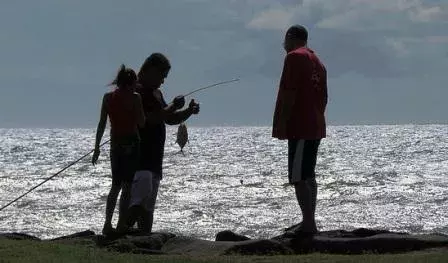Error message

HONOLULU (March 23, 2018)—Following years of population decline, three-fourths of Hawai‘i’s reef fish species are now considered seriously depleted. Over-fishing is one factor contributing to this dramatic loss, but surprisingly little is known about how many fish are actually harvested from Hawai‘i’s nearshore waters.
There is widespread concern about dwindling fish populations but little agreement about how to preserve Hawai‘i’s reef fish and build up their numbers. The strategies that have been proposed to monitor and control nearshore fishing are often met with sharp criticism from the public.
To preserve and build back fish populations, government policymakers and community leaders need to start with accurate estimates of how many fish are actually being harvested every year. They also need to understand the social and cultural importance of Hawai‘i’s fish harvest in order to fully assess what the community stands to lose should coral reef fisheries be mismanaged. But good evidence is hard to find. Speaking at the East-West Center recently, Kirsten L.L. Oleson, University of Hawai‘i Professor of Ecological Economics, described a multi-year research project designed to fill this information gap.
To estimate the annual catch of 57 nearshore fish species, Oleson partnered with former student Shanna Grafeld to study official reports from commercial fishers and fish dealers, plus government estimates of non-commercial catch. They filled out the picture by interviewing key participants in the fishing industry. Finally, to catch a glimpse of trade in reef fish to and from Hawai‘i, they interviewed travelers from Pacific islands arriving at Honolulu International Airport with coolers of fish, and they scanned websites for offers of Hawaiian fish for sale on the US mainland.
Adding everything together, they estimated that nearshore fishing contributes $10–$16 million to Hawai‘i’s economy every year. Roughly three-fourths of these fish are missing from official accounts, however—either caught by commercial fishers but not reported or caught by non-commercial fishers for whom there is no reporting system.
Under the current system, commercial fishers in Hawai‘i hold fishing licenses and are required to report their catch to the state government. Commercial fish dealers may also report their purchases, but for them the reporting system is voluntary. Overall, Oleson and her team estimated that reported sales account for only $3 million of the annual nearshore fish catch in Hawai‘i. The remaining catch—worth $7–$13 million annually—is undocumented.
The study found that fish from Hawai‘i’s shores provide nearly eight million meals a year. This important source of protein, supplied largely by non-commercial fishers, plays a significant, yet unappreciated, role in food security, particularly for people living in rural areas, many of whom are Native Hawaiian.
Interviews also revealed the cultural and social importance of Hawai‘i’s nearshore fisheries. Family members fish together and pass on fishing skills to younger generations. The cultural significance of fishing in Native Hawaiian and other island communities points to an important approach for ensuring the sustainable use of fishery resources: “When communities are involved in fisheries management via community-based or co-management strategies, ecological outcomes can be better than in areas with ‘top-down’ management,” Oleson said. To date, local programs have educated more than 1,500 children and their families on marine conservation and sustainable fishing.
Oleson went on to suggest that expanding Hawai‘i’s “marine managed areas” and increasing protection in these areas could enhance the productive capacity of Hawai‘i’s entire nearshore ecosystem. “Today, Hawai‘i protects about 10 percent of its nearshore area, but the current governor has committed to protecting 30 percent by 2030,” she said.
Based on their broad study of fish marketing, Oleson and her colleagues suggested “a ‘conservation-off-the-hook’ approach where changes in the market system may enhance social, economic, and ecological outcomes.” Interventions could include “improved monitoring of catch and post-catch distribution in order to uncover the extent of unregulated catch and halt illegal commercial catch (currently estimated at 10–30 percent of the volume of legal commercial catch).”
If grocery stores, retailers, wholesalers, and restaurants were required to report their fish purchases, rather than the current voluntary system, “management agencies would have more accurate assessments of fishing pressure, which would be particularly useful in helping state agencies secure ecological and economic sustainability of the fishing industry,” according to Oleson.
Over the years, the most controversial suggestion for documenting Hawai‘i’s nearshore fishing has been to require that non-commercial fishers obtain a license. Oleson suggested that “initiating a licensing scheme for non-commercial fishing would provide an estimate of the number of fishers and would facilitate better research on non-commercial catch.” She acknowledges, however, that non-commercial licensing, when proposed in the past, has met strong resistance from fishers who perceive it as a government effort to regulate their inherent right to fish.
Shanna Grafeld added, “Our study focused on the little-understood benefits of the non-commercial fishery, the number of meals it provides, and its importance to the culture of Hawai‘i in order to highlight what we stand to lose if our nearshore fisheries continue to decline. The goal of any management plan should for the community and fishers to view themselves as partners in conservation.”
Oleson also suggested better monitoring of nearshore fish imported into and exported from Hawai‘i. Although the current volume appears to be small, there is not enough information available today to quantify the flow of reef fish to and from the islands. Grafeld added, “This flow of fish between Pacific islands may be especially important in maintaining regional cultural and family bonds.”
A final intervention point focuses on the end of the value chain—the consumer. “Certification schemes that identify sustainable seafood with a logo or seal can help inform consumers,” according to Oleson. “Consumer education can be as simple as signage posted in markets giving information about fishing regulations and sustainable practices. Programs that affect the purchasing patterns of the major buyers through an improved commitment to sustainable sourcing may be an effective means to improve sustainability.”
“Hawai‘i’s small-scale coral reef fisheries provide large-scale benefits to the islands’ economy, food security, and cultural practices, underscoring the need for sustainable management,” Oleson concluded. “Our research highlights the value of information on these small-scale production systems, making the hidden economy of these fisheries visible and illuminating a range of conservation interventions applicable to Hawai‘i and beyond.”
Kirsten L.L. Oleson is an Associate Professor and Shanna Grafeld is a Junior Researcher in the Department of Natural Resources and Environmental Management at the University of Hawai‘i at Manoa. This East-West Wire is based on Follow that fish: Uncovering the hidden blue economy in coral reef fisheries by Shanna Grafeld, Kirsten L. L. Oleson, Lida Teneva, and John N. Kittinger, published in 2017 in PLOS One.
Download a PDF version of this Wire article.
##
The East-West Wire is a news, commentary, and analysis service provided by the East-West Center in Honolulu. All or any part of the Wire content may be used by media with attribution to the East-West Center or the person quoted. To receive Wire articles via email, subscribe here. For links to all East-West Center media programs, fellowships and services, see www.eastwestcenter.org/journalists.
The full list of East-West Wires produced by the Research Program is available on the East-West Center website. For more on the East-West Center Research Program, see www.eastwestcenter.org/research.
The East-West Center promotes better relations and understanding among the people and nations of the United States, Asia, and the Pacific through cooperative study, research, and dialogue.
Series editors:
Derek Ferrar
[email protected]
Sidney B. Westley
[email protected]
HONOLULU (March 23, 2018)—Following years of population decline, three-fourths of Hawai‘i’s reef fish species are now considered seriously depleted. Over-fishing is one factor contributing to this dramatic loss, but surprisingly little is known about how many fish are actually harvested from Hawai‘i’s nearshore waters.
There is widespread concern about dwindling fish populations but little agreement about how to preserve Hawai‘i’s reef fish and build up their numbers. The strategies that have been proposed to monitor and control nearshore fishing are often met with sharp criticism from the public.
To preserve and build back fish populations, government policymakers and community leaders need to start with accurate estimates of how many fish are actually being harvested every year. They also need to understand the social and cultural importance of Hawai‘i’s fish harvest in order to fully assess what the community stands to lose should coral reef fisheries be mismanaged. But good evidence is hard to find. Speaking at the East-West Center recently, Kirsten L.L. Oleson, University of Hawai‘i Professor of Ecological Economics, described a multi-year research project designed to fill this information gap.
To estimate the annual catch of 57 nearshore fish species, Oleson partnered with former student Shanna Grafeld to study official reports from commercial fishers and fish dealers, plus government estimates of non-commercial catch. They filled out the picture by interviewing key participants in the fishing industry. Finally, to catch a glimpse of trade in reef fish to and from Hawai‘i, they interviewed travelers from Pacific islands arriving at Honolulu International Airport with coolers of fish, and they scanned websites for offers of Hawaiian fish for sale on the US mainland.
Adding everything together, they estimated that nearshore fishing contributes $10–$16 million to Hawai‘i’s economy every year. Roughly three-fourths of these fish are missing from official accounts, however—either caught by commercial fishers but not reported or caught by non-commercial fishers for whom there is no reporting system.
Under the current system, commercial fishers in Hawai‘i hold fishing licenses and are required to report their catch to the state government. Commercial fish dealers may also report their purchases, but for them the reporting system is voluntary. Overall, Oleson and her team estimated that reported sales account for only $3 million of the annual nearshore fish catch in Hawai‘i. The remaining catch—worth $7–$13 million annually—is undocumented.
The study found that fish from Hawai‘i’s shores provide nearly eight million meals a year. This important source of protein, supplied largely by non-commercial fishers, plays a significant, yet unappreciated, role in food security, particularly for people living in rural areas, many of whom are Native Hawaiian.
Interviews also revealed the cultural and social importance of Hawai‘i’s nearshore fisheries. Family members fish together and pass on fishing skills to younger generations. The cultural significance of fishing in Native Hawaiian and other island communities points to an important approach for ensuring the sustainable use of fishery resources: “When communities are involved in fisheries management via community-based or co-management strategies, ecological outcomes can be better than in areas with ‘top-down’ management,” Oleson said. To date, local programs have educated more than 1,500 children and their families on marine conservation and sustainable fishing.
Oleson went on to suggest that expanding Hawai‘i’s “marine managed areas” and increasing protection in these areas could enhance the productive capacity of Hawai‘i’s entire nearshore ecosystem. “Today, Hawai‘i protects about 10 percent of its nearshore area, but the current governor has committed to protecting 30 percent by 2030,” she said.
Based on their broad study of fish marketing, Oleson and her colleagues suggested “a ‘conservation-off-the-hook’ approach where changes in the market system may enhance social, economic, and ecological outcomes.” Interventions could include “improved monitoring of catch and post-catch distribution in order to uncover the extent of unregulated catch and halt illegal commercial catch (currently estimated at 10–30 percent of the volume of legal commercial catch).”
If grocery stores, retailers, wholesalers, and restaurants were required to report their fish purchases, rather than the current voluntary system, “management agencies would have more accurate assessments of fishing pressure, which would be particularly useful in helping state agencies secure ecological and economic sustainability of the fishing industry,” according to Oleson.
Over the years, the most controversial suggestion for documenting Hawai‘i’s nearshore fishing has been to require that non-commercial fishers obtain a license. Oleson suggested that “initiating a licensing scheme for non-commercial fishing would provide an estimate of the number of fishers and would facilitate better research on non-commercial catch.” She acknowledges, however, that non-commercial licensing, when proposed in the past, has met strong resistance from fishers who perceive it as a government effort to regulate their inherent right to fish.
Shanna Grafeld added, “Our study focused on the little-understood benefits of the non-commercial fishery, the number of meals it provides, and its importance to the culture of Hawai‘i in order to highlight what we stand to lose if our nearshore fisheries continue to decline. The goal of any management plan should for the community and fishers to view themselves as partners in conservation.”
Oleson also suggested better monitoring of nearshore fish imported into and exported from Hawai‘i. Although the current volume appears to be small, there is not enough information available today to quantify the flow of reef fish to and from the islands. Grafeld added, “This flow of fish between Pacific islands may be especially important in maintaining regional cultural and family bonds.”
A final intervention point focuses on the end of the value chain—the consumer. “Certification schemes that identify sustainable seafood with a logo or seal can help inform consumers,” according to Oleson. “Consumer education can be as simple as signage posted in markets giving information about fishing regulations and sustainable practices. Programs that affect the purchasing patterns of the major buyers through an improved commitment to sustainable sourcing may be an effective means to improve sustainability.”
“Hawai‘i’s small-scale coral reef fisheries provide large-scale benefits to the islands’ economy, food security, and cultural practices, underscoring the need for sustainable management,” Oleson concluded. “Our research highlights the value of information on these small-scale production systems, making the hidden economy of these fisheries visible and illuminating a range of conservation interventions applicable to Hawai‘i and beyond.”
Kirsten L.L. Oleson is an Associate Professor and Shanna Grafeld is a Junior Researcher in the Department of Natural Resources and Environmental Management at the University of Hawai‘i at Manoa. This East-West Wire is based on Follow that fish: Uncovering the hidden blue economy in coral reef fisheries by Shanna Grafeld, Kirsten L. L. Oleson, Lida Teneva, and John N. Kittinger, published in 2017 in PLOS One.
Download a PDF version of this Wire article.
##
The East-West Wire is a news, commentary, and analysis service provided by the East-West Center in Honolulu. All or any part of the Wire content may be used by media with attribution to the East-West Center or the person quoted. To receive Wire articles via email, subscribe here. For links to all East-West Center media programs, fellowships and services, see www.eastwestcenter.org/journalists.
The full list of East-West Wires produced by the Research Program is available on the East-West Center website. For more on the East-West Center Research Program, see www.eastwestcenter.org/research.
The East-West Center promotes better relations and understanding among the people and nations of the United States, Asia, and the Pacific through cooperative study, research, and dialogue.
Series editors:
Derek Ferrar
[email protected]
Sidney B. Westley
[email protected]
East-West Wire
News, Commentary, and Analysis
The East-West Wire is a news, commentary, and analysis service provided by the East-West Center in Honolulu. Any part or all of the Wire content may be used by media with attribution to the East-West Center or the person quoted. To receive East-West Center Wire media releases via email, subscribe here.
For links to all East-West Center media programs, fellowships and services, see www.eastwestcenter.org/journalists.







